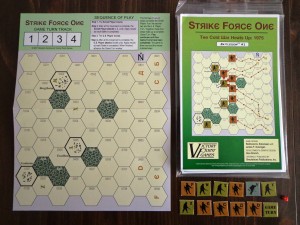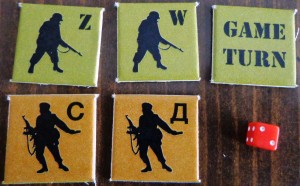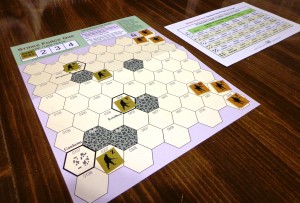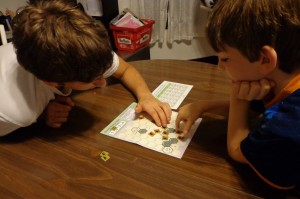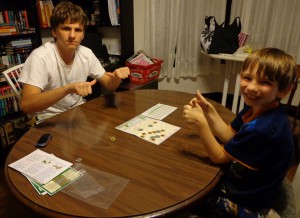“I came here tonight and I didn’t know what to expect. I seen a lot of people hating me and I didn’t know what to feel about that so I guess I didn’t like you much none either. During this fight I seen a lot of changing, the way yous felt about me, and the way I felt about you. In here there were two guys killin each other, but I guess it’s better than 20 million. What I’m trying to say is, that if I can change, and you can change, everybody can change!” – Sylvester Stallone, Rocky IV.
Editor’s Note: Cold War? East versus West? Rocky versus Drago? *Sigh* Watch your Rocky IV, kids.
Strike Force One is a conflict simulator (war game) for two players, designed to introduce newcomers to the genre. One player will take on the role of Soviet forces while the other will take on the role of US forces. The Soviet forces will be trying to occupy at least two of the three towns on the map before four turns are completed. Likewise, the US forces will be trying to prevent this from happening and win if they manage to do so. It’s worth mentioning that there is a standard game as well as an advanced game. The content and gameplay I’ll be describing in this review represent the standard game.
Before we get started with the usual general overview of the game along with my thoughts, I’d like to thank Stephanie Marroquin from Victory Point Games for sending me a free copy of this game to review.
Components
Map – The map is made up of hexes, which represent the battlefield and the spaces that the pieces can move on. These hexes come in a few different forms, such as open hexes, town hexes, and woods hexes. Hexes also contain ID numbers that players can use to record their game move per move, much like professional Chess players do.
Pieces – There are four green and six brown playing pieces, representing the US and Soviet forces, respectively. They are all of equal value, the letters on the pieces used for record keeping purposes.
Aid Sheet – The aid sheet assists players in resolving instances of combat. There are two sides, one for the standard game and one for the advanced game.
Game Turn Counter – This counter helps players keep track of when the game ends. The track for this counter is embedded in the map itself.
Die – The die is used to resolve combat only and has no bearing on movement. The manual notes that players will need to provide their own six-sided die, however the game came with a very small one…more on that in the review.
Setup & Gameplay
Game setup is easy, as the map indicates where each piece starts by displaying a particular letter in some of those hexes.
The game is played over four complete game turns, one turn consisting of the following:
1) The Soviet player moves their units. Once movement is complete, the Soviet player can attack any US unit that is adjacent to their pieces. These battles are resolved before the next step of the game turn.
2) The US player moves their units. Once movement is complete, the US player can attack any Soviet unit that is adjacent to their pieces. These battles are resolved and the game turn ends. The game turn counter is moved along the track appropriately.
All units are limited to moving four hexes per turn and cannot enter woods hexes or end their turn on a hex that contains another piece. Units who enter a space directly adjacent to an enemy unit (called the zone of control) must stop. Leaving an enemy’s zone of control is possible, though a piece can only do so if their next move won’t carry them into a hex where an enemy’s zone of control is in effect.
In regards to combat, attacking is optional, however defending is not. An enemy unit can’t be attacked more than once, and attacking units can only attack once per turn. The die is rolled and the player aid table is used to see what the results are. The defending unit can be eliminated, be forced to retreat, eliminate the attacker, or force the attacker to retreat.
After four full rounds, the Soviets win if they physically occupy two of the three towns on the map. The US wins if they manage to prevent Soviets from completing their goal.
The above is simply an overview of the game. To see the rules in greater detail, please check out the manual here:
The Review
The standard game is incredibly easy to jump into and doesn’t take that long to play. This mode combines a mix of strategy and luck, the latter appearing during combat. A player could play perfectly and surround one enemy unit with three of their own and still not win due to a bad die roll. You can offset the luck factor by including more units in the attack, but eliminating the enemy unit is never guaranteed. This randomness factor does encourage players to play smarter, forcing them to position their pieces in the most optimal position before striking. If players tire of the standard game, they can experience new rules and features in the advanced game. Players will be able to stack units and use woods hexes to provide their units with combat bonuses, just to name a few things.
The components themselves are well thought out…the map has the game turn track, turn instructions, and even a truncated version of the game’s rules right there for both players to see. The hexes have ID numbers on them so that players can record their games, something I don’t see very often in the games that I’ve reviewed. My only complaint is that the manual instructs players to provide their own die, as I feel that games should include all of the components necessary for its use. The small gift die that was included wasn’t received well by my aging eyes or the kids. I was told that packaging issues prevent the inclusion of a regular die…consumers will have to decide for themselves if this is a problem.
Vinnie (11) and I played a few games and enjoyed our experience overall. He told me afterwards that he enjoyed being able to control units, much like he does when playing real-time strategy games on the PC. The US has fewer pieces, giving them a bit of a disadvantage. The fact that there are only four turns helps to offset this disadvantage. Playing as the US was definitely a challenge as I was constantly trying to hold towns without letting my units become surrounded. I found myself throwing a unit or two directly toward the Soviets, hoping that I could play cat and mouse and slow Vinnie down enough to where he wouldn’t have enough time left to occupy the required two towns. Playing as the Soviets was a bit more direct as I had two towns to capture before four turns were up. I couldn’t waste too much time positioning my forces…though I couldn’t ignore the obvious bonuses for doing so. Anthony (16) played two games with Vinnie, taking turns being the Soviet forces. Anthony mentioned that the Soviets were pretty overpowered as they won in both games.
Strike Force One is certainly a good game to use when introducing new players to the war games genre, though novice players may get frustrated playing as the US forces. It’s easy to pick up and play yet provides a fair amount of depth, especially in the advanced game. If you’re interested in trying out these kinds of games but not sure where to start, I’d recommend getting your feet wet with this one first.
Final Verdict: 5/10
—
You can find more information on Strike Force One by visiting the Victory Point Games website or on Board Game Geek, located here:

